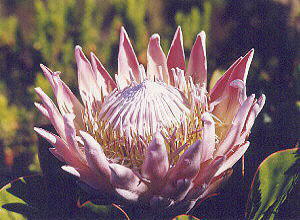November
2002
Did you
know that the South African plant Protea named after the Greek
god Proteus?

|
|
Protea
cynaroides
|
Protea cynaroides
Protea cynaroides, the King Protea,
is surely the best known protea, prized worldwide as a magnificent cut
flower and in South Africa honoured as the national flower.
Protea cynaroides is part of an ancient plant
family, the Proteaceae, which had already divided into two subfamilies, the Proteoideae and the
Grevilleoideae about 140 million years ago.
Both subfamilies, occur mainly
in the southern hemisphere. In southern Africa there are about 360
species. The Australian Proteaceae contain more genera, but it is the South
African ones that have attracted the interest of the world. Protea cynaroides
belongs to the genus Protea, which has more than 92 species,
subspecies and varieties.
The amazing variety in plant size,
habit, flower size and colour of
the genus Protea was the reason that the great Swedish botanist Linnaeus named the genus Protea in 1735 after the Greek
god Proteus, who, according to legend, was able to transform his shape
and appearance into numerous animate and inanimate forms at will. Proteus was the Greek God who looked after Poseidon's
seals. One of
his powers was that he knew the future. For this reason many people
searched for him to find out what their future held. But Proteus did
not willingly part with this information. His favourite trick was to
change shape and escape. Thus to obtain a prophesy from old Proteus
you had to sneak up to him and grab tight. No matter what shape he
took, be it a lion, snake, fire, dragon or water you had to hold tight
lest he escape. If you outlasted him, he would foretell your future.The flower bud
of Protea cynaroides looks remarkably like the globe artichoke
vegetable with the Latin name of Cynara scolymus and this led
the botanist Linnaeus to give it the species name cynaroides.
Protea
cynaroides is a woody shrub with
thick stems and large dark green, glossy leaves. Most plants are one
metre in height when mature, but may vary according to locality and
habitat from 0.35 m to 2 metres in height.
The "flowers" of Protea cynaroides are actually
flower heads with a collection of flowers in the centre, surrounded by
large colourful bracts. The flowerheads vary in size, from about 120
mm to 300 mm in diameter. Large, vigorous plants produce six to ten
flower heads in one season, although some exceptional plants can
produce up to forty flower heads on one plant. The colour of the
bracts varies from a creamy white to a deep crimson, but the soft pale
pink bracts with a silvery sheen are the most prized.
The natural habitat of Protea ranges in elevation from sea
level to over 2000 m. The combination of the different
climatic conditions with the large range of localities has resulted in
a large variety of leaf- and flower sizes, as well as flower colours
and flowering times. The different forms retain these characteristics
even when grown under the same conditions on a commercial scale. This
has made it possible to grow Protea cynaroides as a cut flower
for a wide variety of export markets, where the flowers are needed at
different times of the year. This South African protea is now grown in
large quantities in New Zealand, Australia and Hawaii. In
Mediterranean climates in Europe, America en Australia it can be grown
successfully as a garden plant in the right type of soil.
Source:
http://protea.worldonline.co.za/proteus.htm
http://www.hort.purdue.edu/newcrop/proceedings1999/v4-410.html
http://www.plantzafrica.com/plantnop/proteacyna.htm
|
